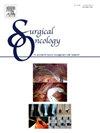腹腔镜胰十二指肠切除术中的肝韧带和镰状韧带 "腰带和支架 "法,使用改良的 Blumgart 吻合器,最大限度地减少严重的胰瘘和术后并发症
IF 2.3
4区 医学
Q3 ONCOLOGY
引用次数: 0
摘要
背景为了确定在胰十二指肠切除术(PJ)中,包裹胃十二指肠动脉(GDA)并加固后壁的肝韧带和镰状韧带是否能保护GDA残端和其他骨骼血管免受侵蚀性出血,并降低腹腔镜胰十二指肠切除术(LPD)后临床相关的术后胰瘘(CR-POPF)和术后并发症的发生率。方法我们回顾了2019年1月至2023年6月期间接受腹腔镜胰十二指肠切除术的患者。根据韧带瓣是用于包裹GDA残端(A组)还是用于加固PJ后壁以及GDA包裹术(B组),将患者分为两组。我们回顾了围手术期的数据,以确定这种方法在预防 CR-POPF、胰腺切除术后出血(PPH)和其他并发症方面的有效性。B组患者的≥II级Clavien-Dindo分类发病率和CR-POPF明显较低(P < 0.05),住院时间(LOS)和腹腔引流管插入时间也较短。结论 LPD中的韧带瓣应用为PJ下的GDA残端和其他骨骼血管提供了免受消化液侵蚀的庇护,加固了PJ后壁,降低了CR-POPF和≥Ⅱ级Clavien-Dindo分类发病率。这种简单的手术能有效提高 LPD 的手术安全性。本文章由计算机程序翻译,如有差异,请以英文原文为准。
A ligamentum teres hepatis and falciform ligament ‘belt and braces’ approach in laparoscopic pancreaticoduodenectomy using a modified Blumgart anastomosis to minimize severe pancreatic fistula and post-operative complications
Background
To determine whether ligamentum teres hepatis and falciform ligament, wrapped around the gastroduodenal artery (GDA) and reinforced the posterior wall in pancreatojejunostomy (PJ), protects the GDA stump and other skeletal blood vessels from erosive hemorrhage and reduces the incidence of clinically relevant post-operative pancreatic fistula (CR-POPF) and post-operative complications after laparoscopic pancreaticoduodenectomy (LPD).
Methods
We reviewed patients undergone LPD between January 2019 and June 2023. Patients were divided into two groups according to whether the ligamentous flap had been used to wrap the GDA stump (Group A) or to reinforce the posterior wall in PJ, together with the GDA wrapping procedure (Group B). Peri-operative data were reviewed to determine the effectiveness of this approach in preventing CR-POPF, post-pancreatectomy hemorrhage (PPH), and other complications.
Results
We enrolled 272 patients (Group A, 154 patients; Group B, 118 patients). Group B patients had significantly fewer ≥ Grade II Clavien–Dindo classification morbidities and CR-POPFs (P < 0.05), and lower length of hospital stay (LOS) and abdominal drainage tube insertion times. Risk factor analysis indicated that main pancreatic duct dilation, the PJ reinforcement procedure, and soft pancreatic tissue were associated with ≥Grade II Clavien–Dindo morbidities and CR-POPF complications.
Conclusions
The ligamentous flap application in LPD provided shelter to GDA stump and other skeletal blood vessels under PJ from erosive digestive juices, reinforced the posterior wall in PJ, reduced the incidence of CR-POPF and ≥Grade II Clavien–Dindo classification morbidities. This simple procedure is effective for improving surgical safety of LPD.
求助全文
通过发布文献求助,成功后即可免费获取论文全文。
去求助
来源期刊

Surgical Oncology-Oxford
医学-外科
CiteScore
4.50
自引率
0.00%
发文量
169
审稿时长
38 days
期刊介绍:
Surgical Oncology is a peer reviewed journal publishing review articles that contribute to the advancement of knowledge in surgical oncology and related fields of interest. Articles represent a spectrum of current technology in oncology research as well as those concerning clinical trials, surgical technique, methods of investigation and patient evaluation. Surgical Oncology publishes comprehensive Reviews that examine individual topics in considerable detail, in addition to editorials and commentaries which focus on selected papers. The journal also publishes special issues which explore topics of interest to surgical oncologists in great detail - outlining recent advancements and providing readers with the most up to date information.
 求助内容:
求助内容: 应助结果提醒方式:
应助结果提醒方式:


